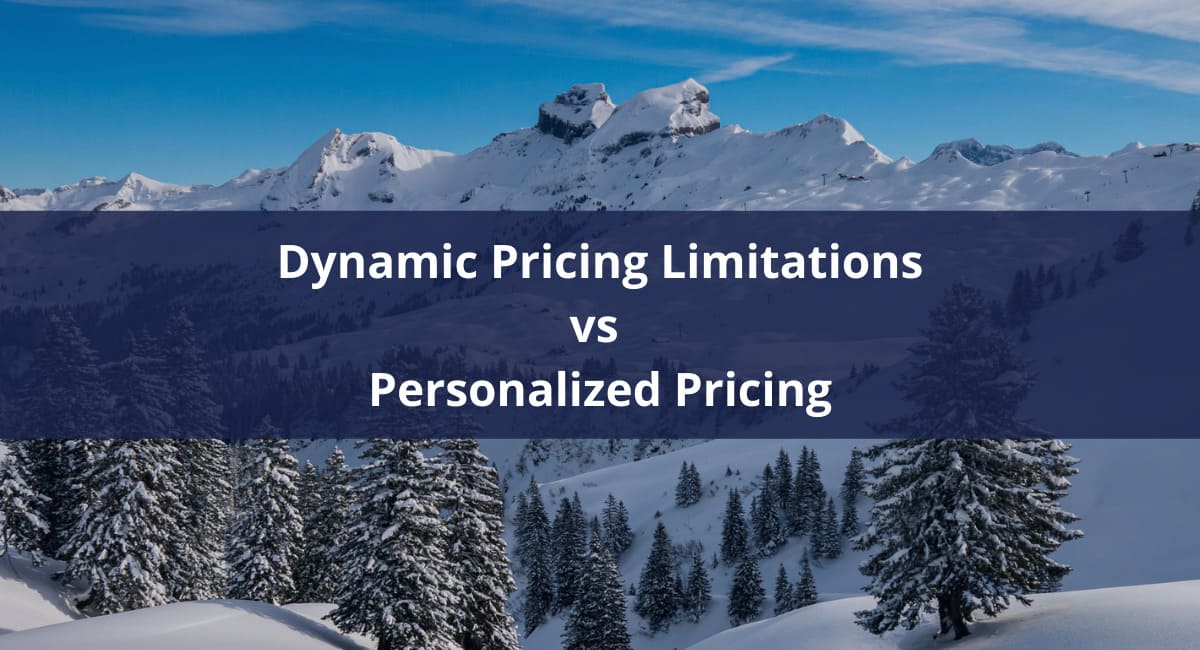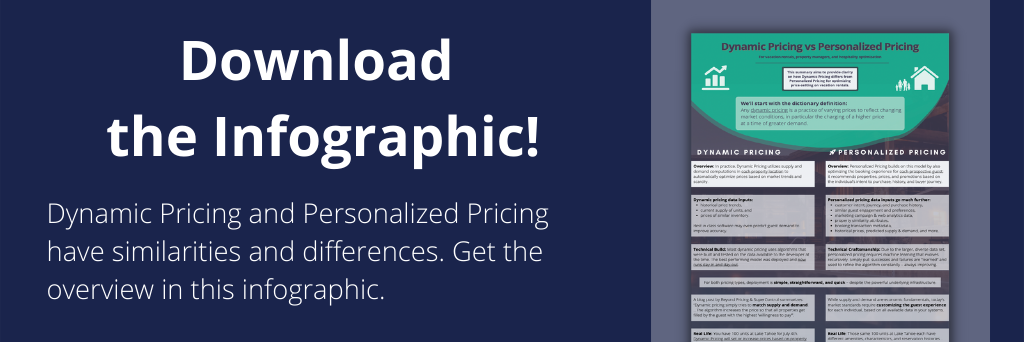The goal of this article is to share the differences between traditional dynamic pricing methodology currently in mass use, versus a customer-centric approach to personalizing pricing. You should come away with an understanding of both methods and how they work in vacation rental pricing.
For a quick and painless overview of the core differences, check out our infographic that gives a side-by-side comparison between the two approaches. You can view or download it here.
Introduction
For many years, whether setting prices on vacation rentals or on home purchases, the value has been based on economic fundamentals of supply and demand. (It calls to mind the high school “Econ” class supply vs demand graph: two curves creating a cartesian X.)
In short, this was a representation of making choices based on market scarcity: prices went up or down based on the supply of inventory and the amount of demand.
Since scarcity can be localized to given sub-regions, the demand and availability for properties in each market have been used to dictate prices for other properties in that market.
If all of the data about home values and rent prices are available, we immediately have the means (information) to automatically set prices based on this traditional logic. We call this dynamic pricing, as it dynamically generates prices based on the market. Others call it supply-side pricing.
Technology vendors started popping up that helped to automate this dynamic pricing – building the software that made that calculation scalable. And further, those software companies integrated those data and calculations to actually “push” those price values automatically into the customer-facing platforms & channels: starting with your own website.
And thus began an incredible journey!
Technology became adept at aggregating price data and highlighting the variations between homes in each market – then selecting a price that fit the scene. This not only helped to ensure a price that was at least the fair market value, but it also saved a ton of time for those vacation rental managers who were in charge of setting and updating prices on a weekly or monthly basis.
But that’s not the end of the journey…
Dynamic pricing: an overview
Based on what we’ve already discussed, we have a fundamental understanding of the “dynamic pricing” that is currently widespread in the vacation rental management industry. But let’s discuss it in a bit more detail.
The data inputs used by dynamic pricing software are fairly straightforward: historical price trends, current supply of properties, and the prices of similar inventory in the market. There are both public and private sources available that provide this type of information.
The best-in-class software may even use some historical demand numbers for your own properties – or maybe the number of initial inquiries – as an additional data point to make marginal price adjustments up or down.
The underlying programming and technical build-out here uses algorithms that were built and tested on the heaps of data available to the developer. The result was a form of artificial intelligence: it is ingesting a lot of input data and using engineered rules and logic to calculate and select the right output. This is called rule-based logic.
The best performing model was then deployed and runs day-in and day-out to optimize prices. Of course when innovative ideas arise, there are periodic updates to the system.
Confirming what dynamic pricing is not
A blog post by Beyond Pricing & SuperControl summarizes what this technique is aimed at: “Dynamic pricing simply tries to match supply and demand. …The algorithm increases the price so that all properties get filled by the guest with the highest ‘willingness to pay’”.
This quote is informative as it reaffirms what we’ve discussed about the supply and demand curves. However, there are multiple interpretations for the second half of the statement – I’ll break apart and clarify both.
In one interpretation, the “guest with the highest willingness to pay” may imply that the algorithm is actually making a determination about each guest and their individual willingness to pay. And then subsequently making a price decision for that person. This is actually not what’s happening in dynamic pricing.
The second meaning holds the truth. The guest’s “willingness to pay” is actually assumed… because it is already built-in to the market prices. This is because the price is set by the invisible hands of supply and demand that drive prices up or down. If there is higher customer-demand in that market overall, prices will rise until people are no longer willing to pay more. So when the dynamic pricing algorithm sets the price based on guests’ “willingness to pay”, it is setting a market price that has already taken into account the market’s overall demand.
That distinction is actually very important. Why? Because it shines a direct light on the next question: what would happen if we could customize prices based on each individual guest?
Well, we’re about to get there!
More data from your business
To make better decisions, we need more information.
Your business systems are a (figurative) gold mine for making better pricing decisions. These systems make customer workflows, business processes, and tracking easy to manage, but they also store a ton of data at every step of the way. I’ll provide a few examples to be clear.
- Website analytics: Google Analytics tracks and stores data on every website interaction, time spent, journey from page to page, entry points and exit points, and different key events that happen (filtering for amenities, filling forms, hitting certain landing pages, clicking different buttons).
- Property management: Your PMS holds all of your properties and their related attributes: all the images, the size, bed/bath, amenities, location, list price, etc.
- Transactions: data is available from the date & time of bookings to the payment method, the amounts, the discounts, the time between booking and check-in date, the device (mobile/desktop), and more.
- Customers: Your CRM has the booking history, preferences, basic demographics, contact information, feedback responses, and other specialty attributes you may ask customers for (e.g., birthdate, gender, subscriptions).
While the above are just some examples, you’re probably imagining what types of systems you have integrated for your business and the various bits and pieces that are being captured every day.
Okay, cool. That data exists – but how do you use it to make more individualized price recommendations?
Personalized pricing
First, it may be helpful to note the dictionary definition for “dynamic pricing”: a practice of varying prices to reflect changing market conditions, in particular the charging of a higher price at a time of greater demand.
Personalizing prices is still dynamic, but it puts emphasis on a customer-centric approach in addition to property-centric.
This new approach will look at each website visitor, or returning guest, and predict that person’s…
- lifetime value to your company;
- the properties that they are most likely to book next;
- the prices for each property that have the highest probability of converting to a booking;
- the timeframe that each individual books in;
- the similarity to other guests;
- and other higher-performance correlations.
To do all of this, it needs the right information.
Personalized pricing data inputs go much further than traditional dynamic pricing. (The types of data listed above are a start.)
Some quick examples: customer intent, journey, and purchase history; similar guest engagement and preferences; marketing campaign & web analytics data; property similarity attributes; booking transaction metadata; historical prices; predicted supply & demand; and more.
Due to the larger, diverse data set, personalized pricing requires a technical solution that is much more robust – a powerhouse; a workhorse; a machine. To make this possible, it uses machine learning that evolves recursively. (Download our free “What is Machine Learning” two page overview here!)
To keep it simple in this post, machine learning is designed to make predictions or decisions by itself, without being explicitly programmed to do so. It trains on historical data to learn patterns, and then uses new data in real-time to learn and adjust – creating a continuous feedback loop. It deploys statistical models to predict probabilities across millions (or billions) of permutations and calculates the right inputs to meet your desired goals.
Ultimately, this “ML” provides the infrastructure and engine to personalize pricing based on all the available data. Human analysts, or even strong software algorithms, cannot accomplish the same level of thoroughness, accuracy, and speed that ML systems can.
The outcome? Your ability to individualize prices for your prospective guests on your website experience, email campaigns, and more. That imagined hypothesis is actually a reality.
The winds of change
Today’s market standards require customizing the guest experience for each individual. Consumers – across every industry, not just hospitality – demand that personalized touch, custom experiences, and seamless technological workflows.
It’s not simple to keep up with these trends, but it’s certainly a massive help to use the software that makes these jobs easier.
Historically, powerful software vendors like Beyond Pricing, Wheelhouse, and Price Labs led the charge on innovative ways to save time and optimize prices. And now that they’ve been around, they’ve set a new standard – without a tool that helps to automate prices dynamically, you simply cannot operate at scale in today’s world.
The quickly emerging practice of focusing on the customer and personalizing their booking experience, however, is now taking a front seat on this journey. The new gold standard is being able to individualize the guest’s interactions with your brand to the extent that you start to impact their buying decisions.
This shift doesn’t come without some caveats, of which I’ll name two. First, we need to consider the impact of how using guest data can create types of negative or harmful discrimination. Understanding ethics in technology is important to maintain a responsible society and ecosystem of business operations. So this point should be kept in mind.
While less severe, another consideration is whether an ML solution to personalize pricing can even work for your business. You may need to qualify with enough data or other attributes in your business. That is a reason to do additional research – or a data assessment – as to the potential fit in your vacation rental company. Who knows… maybe your business is already optimized the best it possibly can be for the size of your operation!
Conclusion
In practice, Dynamic Pricing utilizes supply and demand computations in each property location to automatically optimize prices based on market trends and scarcity.
Personalized Pricing builds on this model by also optimizing the booking experience for each prospective guest; it recommends properties, prices, and promotions based on the individual’s intent to purchase, history, and buyer journey.
The new model saves you time, generates higher overall returns, and customizes the guest experience. The combined property-centric and customer-centric methodology maximizes both conversion rates & profit margin. Dynamic Pricing is powerful to replace manual workload – but the limitations of a solely property-centric approach miss out on all the benefits of personalizing your guest experience.
The industry-leading Personalized Pricing offered by Jarvis ML can ingest all data sources available within a vacation rental management business to identify any correlations that may inform better decisions. By introducing a machine learning engine into your tech-stack, you’ve opened up opportunities to grow, optimize, and create efficiency.
A recent Forbes article on ‘Understanding The Future of Dynamic Pricing’ walks through some of these same changes that have happened in the market of real estate and vacation rental pricing. The article emphasizes the impact of machine learning on pricing in the real estate:
“With the explosion of the real estate market intersecting as it did with the initial deployments of machine learning technology, we have perhaps only seen the end of the beginning of price disruption on a global scale… [which] may very well have been born in real estate pricing.”






